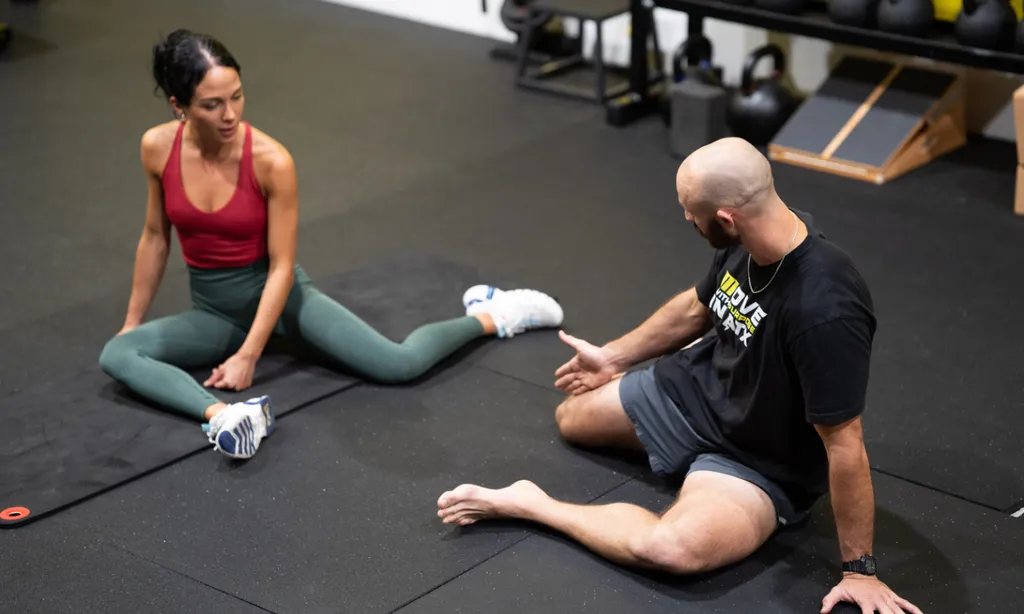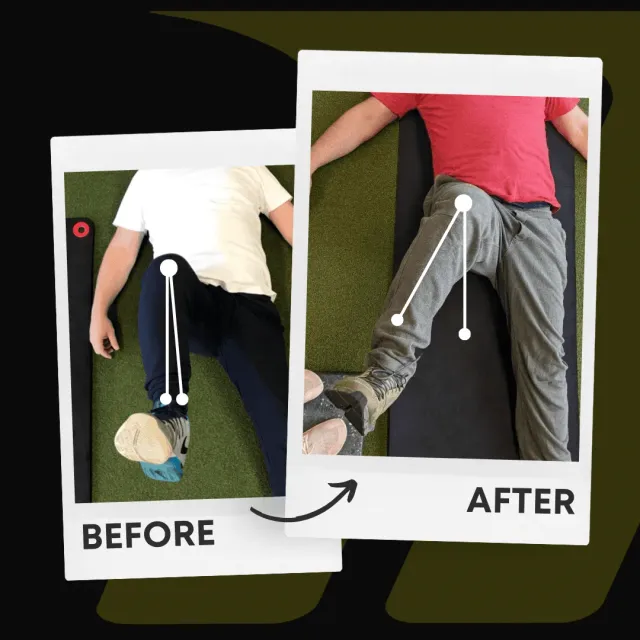You Can't Move Where You Can't Move
December 10, 2021 | Functional Range Conditioning

“You can’t move where you can’t move.” – Dr. Andreo Spina
This statement might sound obvious, but it carries a deeper truth that most people overlook. Your body doesn’t have unlimited options. It only moves in the ways it has been trained or allowed to move. If you lack access to certain ranges of motion, your body can’t utilize them in training, sports, or daily life.
This isn’t a question of effort or willpower. It’s about access.
The Path of Least Resistance
Your body is built to survive and conserve energy. That means it naturally chooses the path of least resistance.
- If your hips lack internal rotation, your knees or spine will make up the difference when you squat.
- If your ankles don’t dorsiflex, your knees collapse inward, or your heels lift off the ground.
- If your shoulders lack rotation, your spine arches excessively just to get weight overhead.
These compensations become your “normal.” But over time, they add stress to tissues, create mechanical inefficiencies, and often result in injury.
The path of least resistance may seem efficient in the short term, but it’s actually a trap. Long-term, it limits growth and performance.
Range of Motion Is the Currency of Movement
Think of range of motion (ROM) as the spending currency of movement. Without it, your options shrink. With it, your body can explore, adapt, and thrive.
- Limited hips = awkward squats, reduced stride length, recurring back pain.
- Limited shoulders = pressing discomfort, weak throwing mechanics, poor posture.
- Limited ankles = shallow squats, inefficient gait, and added stress on knees and hips.
Your ability to squat, hinge, push, pull, run, or throw is directly capped by the ranges you own. You can’t get strong in a position you can’t reach.
That’s why systems like Functional Range Conditioning are so effective. They don’t just “stretch” muscles; they expand usable ranges at the joint level and train you to control them under load.
Why All Joints Are Rotational
Rotation is the foundation of joint health. Nearly every joint in the human body—hips, shoulders, knees, ankles, wrists—depends on rotational capacity.
Rotation allows a joint to:
- Accept and redistribute force.
- Move efficiently in multiple planes.
- Protect tissue by spreading stress.
When a joint loses rotation, it also loses adaptability. A hip without internal rotation creates spinal stress. A shoulder without rotation compromises pressing. Over time, these missing pieces don’t just hold you back—they wear you down.
This is why our Functional Range Assessment prioritizes rotation. If a joint can’t rotate, it can’t truly function.
Side note here: the spine is different, and although it’s rotational in nature, it’s a flexion/extension system. Thus, for the spine, we prioritize segmental motion in flexion and extension first.
The Nervous System Decides What You Can Do
Mobility is not just a tissue problem—it’s a nervous system problem. Your brain decides what ranges you’re allowed to use.
If your nervous system perceives a position as unsafe, it shuts down access. That’s why you can feel “tight” even when muscles aren’t short. It’s protective tension.
Through methods like Controlled Articular Rotations (CARs), we reintroduce the nervous system to positions it once rejected. Over time, your body learns to accept these ranges as safe. That’s when lasting change happens—not from passive stretching, but from active, nervous-system-driven training.
Strength Is Built on Mobility
Here’s the mistake most people make: they try to build strength on top of dysfunction.
- You want to squat deeper? First, earn hip and ankle mobility.
- You want to overhead press without pain? First, earn rotational capacity in your shoulders.
- You want to run faster or longer? First, earn resilient hips and ankles.
Strength without mobility only reinforces dysfunctional patterns. Strength built on mobility creates resilience. That’s why we call mobility “strength training at the joint level.”
Mobility vs. Stretching
Stretching and mobility are not the same thing.
- Stretching = passive. You’re pulled into a position, but you don’t control it.
- Mobility training = active. You expand range and strengthen tissues so you can own the position.
Passive flexibility doesn’t carry over into real movement. You might touch your toes, but if you can’t control that position, it won’t help you lift, run, or stay injury-free.
Mobility training makes ranges usable. It strengthens connective tissue, improves joint health, and integrates those ranges into how you move every day.
For a deeper dive, see Stretching Is Training.
How Modern Life Shrinks Your Movement Options
Even in active cities like Austin, daily routines erase ranges of motion:
- Tech workers spend long hours at desks, creating stiff spines and locked hips.
- Endurance athletes—runners, cyclists, triathletes—train linear patterns over and over, rarely exploring rotation.
- Parents and busy professionals stick to the same limited movement patterns, repeating what feels familiar.
None of this is laziness. It’s adaptation. Your body responds to what you repeatedly do. If you don’t train rotation, you lose it. If you don’t train deep ranges, they disappear.
Mobility training restores what modern life takes away.
Inputs That Expand Movement
Mobility isn’t random—it’s systematic. These are some of the most effective tools:
- Controlled Articular Rotations (CARs): Daily maintenance for joint health. See our CARs breakdown.
- PAILs/RAILs: Isometric contractions that expand range while strengthening new positions. Learn about PAILs/RAILs here.
- End-Range Strength: Training connective tissue in its weakest zones to bulletproof joints.
- Capsular Work: Expanding the deepest layer of joint space so it can accept more input.
These aren’t gimmicks. They’re progressive strategies that give your body access to ranges it can actually use.
Why Mobility Matters for Everyone
Mobility isn’t just for athletes or those in pain. It’s for anyone who wants to:
- Prevent injury. Gaining access to more ranges reduces compensations.
- Train harder. Greater joint capacity allows you to handle more load safely.
- Age better. Joint health determines independence as much as strength or cardio.
- Move freely. Sports, hobbies, and daily life all improve when you expand your options.
That’s why our mobility coaching in Austin resonates with so many populations—from athletes to retirees. Mobility is the great equalizer.
The Big Picture
“You can’t move where you can’t move” is more than a phrase—it’s a reality check. If a joint doesn’t have access to a range, everything built on top of it is compromised. That includes strength, skill, and longevity.
Mobility training is the missing link. It creates access, builds strength from the inside out, and ensures your body isn’t limited by old habits or lost ranges.
When you expand joint capacity, you expand your life.
FAQs
What’s the difference between flexibility and mobility?
Flexibility is how far a joint can move passively. Mobility is how much you can control actively. Mobility is what translates to performance and longevity.
Can mobility training replace stretching?
Yes. Mobility training delivers all the benefits of stretching while adding strength and neurological control, making it a more complete solution.
How often should I train mobility?
Daily is best. Five to ten minutes of CARs can maintain joint health, while dedicated sessions 2–3 times per week build real progress.
Is mobility training just for athletes?
No. Mobility is foundational. Athletes use it to improve performance, but non-athletes benefit by reducing pain, moving more freely, and maintaining independence with age.
Written by
Brian Murray, FRA, FRSC
Founder of Motive Training
We’ll teach you how to move with purpose so you can lead a healthy, strong, and pain-free life. Our headquarters are in Austin, TX, but you can work with us online by signing up for KINSTRETCH Online or digging deep into one of our Motive Mobility Blueprints.




